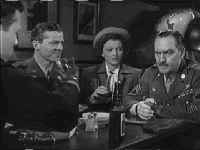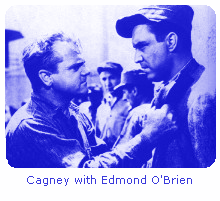 :
Study
Questions: Week One
:
Study
Questions: Week One  :
Study
Questions: Week One
:
Study
Questions: Week One
Reaching for the American Dream
The Best Years of Our Lives (1946)
White Heat (1949).
Grand Expectations and Renewed Anxieties: "A Decent Job, a Mild Future, and a Little House Big Enough for Me and My Wife," or "Look Ma, I'm Top of the World!"
 In
this pair of films we want to explore two very different visions of post-World
War II industrial America. They each portray a group of characters entering
an urban America which demands that they adapt to a society which has been undergone
many social and economic changes. In The Best Years of Our Lives (BYOL) the
focus is a group of returning veterans, while in White Heat (WH) the focus is
on the Jarrett Gang which must move from the rural West to post-war Los Angeles.
While William Wyler's film addresses these changes directly by making them explicit
aspects of the lives of the three Boonesville veterans, Raoul Walsh's film tends
to treat these changes indirectly by displacing them onto the familiar conventions
of the gangster film. Yet the striking parallels between the two films help
reveal the hopes and the anxieties which found their way into America's most
popular narrative medium in the decade following World War II. In response to
student requests in previous courses, the study questions have been grouped
by film rather than by topic.
In
this pair of films we want to explore two very different visions of post-World
War II industrial America. They each portray a group of characters entering
an urban America which demands that they adapt to a society which has been undergone
many social and economic changes. In The Best Years of Our Lives (BYOL) the
focus is a group of returning veterans, while in White Heat (WH) the focus is
on the Jarrett Gang which must move from the rural West to post-war Los Angeles.
While William Wyler's film addresses these changes directly by making them explicit
aspects of the lives of the three Boonesville veterans, Raoul Walsh's film tends
to treat these changes indirectly by displacing them onto the familiar conventions
of the gangster film. Yet the striking parallels between the two films help
reveal the hopes and the anxieties which found their way into America's most
popular narrative medium in the decade following World War II. In response to
student requests in previous courses, the study questions have been grouped
by film rather than by topic.
Please comment on which method seems more useful. The next set of questions will begrouped by topic for comparison.
1. BYOL opens in an airport and airports and planes figure prominently throughout the film. What does this emphasis on a new technology (especially in reference to the Boone City Airport) say about the way post-war America has changed? How is it related to other social and economic changes dramatized in the film? For example, in what ways do the three central male characters reflect a cross-section of both the military world and of a larger American society? Think about their respective uniforms, their social backgrounds, and their fears and desires.
2. What is the thematic significance of the taxi ride through Boone City. How do the passing images serve to create a paradigm of American society and cultural values? What is the origin of the city's name? Where in the United States is it located?
3. Considering the structure and the values embodied in the three families (Stephensons, Parrishes, and Derrys), what can you deduce about the superiority of the higher social classes?
4. In what ways do the Stephenson children serve as idealized examples of what were considered appropriate gender roles in the post-war years? Why do they look as much like a magazine advertisement as an actual picture of life?
5. In the film's opening sequence Frank Derry, the poor boy with dreams, announces, "All I want is a good job, a mild future, and a little house big enough for me and my wife." How does this statement link the American Dream to the film's central theme?
6. What reservations does Al Stephenson have about returning to his job at the bank? How has his military experience changed his views about the social responsibility of financial institutions? Consider his speech to his colleagues and his treatment of Novak (the farmer seeking a loan)?
7. What specific actions establish Millie Stephenson at the film's ideal woman, her husband's wife/mother/mistress. What, by implication, do these actions, suggest about the maturity of American men? In what ways does she serve as a contrast to Wilma Cameron and Marie Derry?
8. What does the sale of Bullard's Drugstore suggest about the economic changes taking place in post-war America and about their ability to reshape the lives of individuals? How does the comparison between old "Doc" Bullard and the vulpine Mr. Thorpe, the new store manager, pass judgment on these changes?
9. Describe briefly the various reactions of Harold Parrish's family (including Wilma and her parents) to his handicap. Do these reactions reflect an overly optimistic view of human nature?
10. In what ways might Peggy Stephenson be seen as embodying contradictory conceptions of gender roles? How might these contradictions foreshadow the feminist movement of the 1960s"
11. When Marie Derry abandons her husband for a more glamorous (and more tacky) way of life, she claims, "I gave up the best years of my life." Why is her statement the antithesis of the way the phrase is used in the film's title? In what ways does she represent a perversion of the American Dream.
12. How does the film's final scene, The wedding of Wilma and Harold, embody the conclusion of a classic comedy? How do the pairs of characters, the communal ritual, and the future promise represent a triumph of the American Dream over the threats is faced throughout the film? For instance, what does the union of Frank and Peggy say about social mobility? Try to find more examples.
13. Although disguised by the optimistic resolution of the narrative, in what ways does BYOL dramatize a significant conflict between the promises inherent in the American Dream and the changes taking place in the developing post-industrial, corporate economy?
14. In what important ways does Cody Jarrett's family in WH represent a negation of the values embodied in the Stephenson and Parrish families in BYOL?
15. How does the movement of the film's narrative action from the rural California mountains to post-industrial Los Angeles reflect changes taking place during the late 1940s? In what ways do the new Boonesville airport in BYOL and the maze-like oil petroleum refinery in WH symbolize the same changes? Why does the former seem beneficial while the latter seems sinister and entrapping?
16. What does the fate of Cookie (who is scalded by steam) say about the nature of the bond among gang members? How does the behavior of Big Ed reflect the same qualities? What sort contrasts can you see between the Jarrett Gang and the social bonds uniting the veterans in BYOL?
17. Could you say that the conflict between Ma Jarrett and Verna reflects more than a struggle between mother and wife? How might it reflect a difference in generations, in shifting values? How might it be seen as dark twin of the relationship between Millie Stephenson and her daughter Peggy? 1
18. WH places a great deal of emphasis on the police (actually Treasury agents). In what ways do they reflect the forces of technological progress and increasingly centralized social institutions? Consider the devices used to track down Cody. Also, are Evans and his "college-educated" and neatly-dressed assistants more or less appealing than the members of the Jarrett gang? Why does the film stress this visual contrast and what does it signify?
19. In what ways do both films depict powerful institutions (banks, the Treasury Department, large corporations) as dangers to individual independence?
20. The years after World War II were often described as the "age of analysis," a period when popularized theories of psychoanalysis appeared throughout American culture. How might this influence be seen in the explanation of Cody's "headaches" and his treatment in prison (particularly his attachment to Fallon)?
21. Cody, whose criminal behavior is determined by his psychological dependence on his malevolent mother, might be contrasted to the three veterans in BYOL, whose behavior is determined by their social circumstances. How does this contrast help account for the fates of the characters in each film?
22. What are we to make of Fallon, the undercover agent? Is he a character to be admired? Or might he be seen as flawed as the man he hunts? What are the reasons for your judgment? What is the significance of having Fallon become the sniper who finally destroys Cody? What does his behavior say about the relative value of personal as opposed to institutional loyalty?
23. Fred Derry is, in many ways, similar to Cody Jarrett. Their wives are played by the same actress (Virginia Mayo), and they betray their husbands with a character played by the same actor (Steve Cochran). How does each character's response to his wife's infidelity help determine his fate?
24. Why is the chemical plant, a world of endless machinery an appropriate place for Cody to meet his fate? If a classic comedy ends with a marriage and the classic tragedy ends with the death of the isolated protagonist, could you use these terms to describe BYOL and WH? Why? Why not?